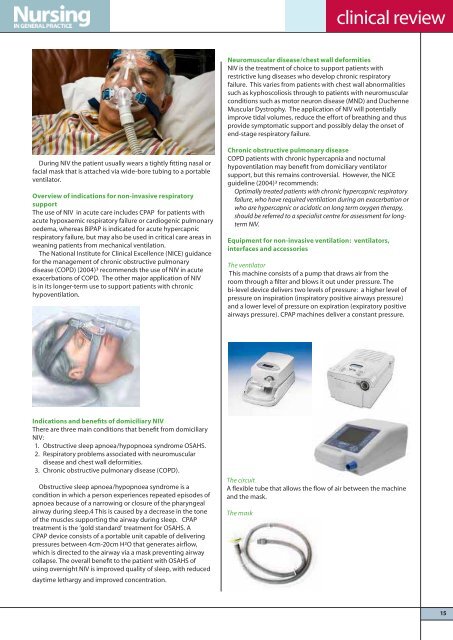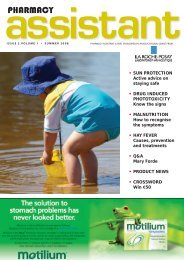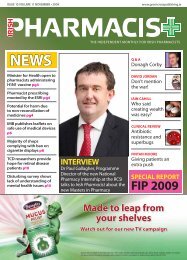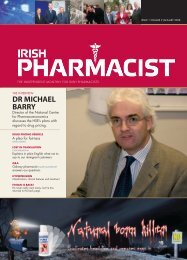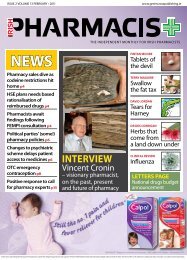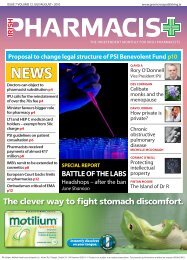veNTIlATIoN - Green Cross Publishing
veNTIlATIoN - Green Cross Publishing
veNTIlATIoN - Green Cross Publishing
You also want an ePaper? Increase the reach of your titles
YUMPU automatically turns print PDFs into web optimized ePapers that Google loves.
During NIV the patient usually wears a tightly fitting nasal or<br />
facial mask that is attached via wide-bore tubing to a portable<br />
ventilator.<br />
overview of indications for non-invasive respiratory<br />
support<br />
The use of NIV in acute care includes CPAP for patients with<br />
acute hypoxaemic respiratory failure or cardiogenic pulmonary<br />
oedema, whereas BiPAP is indicated for acute hypercapnic<br />
respiratory failure, but may also be used in critical care areas in<br />
weaning patients from mechanical ventilation.<br />
The National Institute for Clinical Excellence (NICE) guidance<br />
for the management of chronic obstructive pulmonary<br />
disease (COPD) (2004)³ recommends the use of NIV in acute<br />
exacerbations of COPD. The other major application of NIV<br />
is in its longer-term use to support patients with chronic<br />
hypoventilation.<br />
<br />
Indications and benefits of domiciliary NIv<br />
There are three main conditions that benefit from domiciliary<br />
NIV:<br />
1. Obstructive sleep apnoea/hypopnoea syndrome OSAHS.<br />
2. Respiratory problems associated with neuromuscular<br />
disease and chest wall deformities.<br />
3. Chronic obstructive pulmonary disease (COPD).<br />
Obstructive sleep apnoea/hypopnoea syndrome is a<br />
condition in which a person experiences repeated episodes of<br />
apnoea because of a narrowing or closure of the pharyngeal<br />
airway during sleep.4 This is caused by a decrease in the tone<br />
of the muscles supporting the airway during sleep. CPAP<br />
treatment is the ‘gold standard’ treatment for OSAHS. A<br />
CPAP device consists of a portable unit capable of delivering<br />
pressures between 4cm-20cm H²O that generates airflow,<br />
which is directed to the airway via a mask preventing airway<br />
collapse. The overall benefit to the patient with OSAHS of<br />
using overnight NIV is improved quality of sleep, with reduced<br />
daytime lethargy and improved concentration.<br />
<br />
clinical review<br />
Neuromuscular disease/chest wall deformities<br />
NIV is the treatment of choice to support patients with<br />
restrictive lung diseases who develop chronic respiratory<br />
failure. This varies from patients with chest wall abnormalities<br />
such as kyphoscoliosis through to patients with neuromuscular<br />
conditions such as motor neuron disease (MND) and Duchenne<br />
Muscular Dystrophy. The application of NIV will potentially<br />
improve tidal volumes, reduce the effort of breathing and thus<br />
provide symptomatic support and possibly delay the onset of<br />
end-stage respiratory failure.<br />
chronic obstructive pulmonary disease<br />
COPD patients with chronic hypercapnia and nocturnal<br />
hypoventilation may benefit from domiciliary ventilator<br />
support, but this remains controversial. However, the NICE<br />
guideline (2004)³ recommends:<br />
Optimally treated patients with chronic hypercapnic respiratory<br />
failure, who have required ventilation during an exacerbation or<br />
who are hypercapnic or acidotic on long term oxygen therapy,<br />
should be referred to a specialist centre for assessment for longterm<br />
NIV.<br />
equipment for non-invasive ventilation: ventilators,<br />
interfaces and accessories<br />
The ventilator<br />
This machine consists of a pump that draws air from the<br />
room through a filter and blows it out under pressure. The<br />
bi-level device delivers two levels of pressure: a higher level of<br />
pressure on inspiration (inspiratory positive airways pressure)<br />
and a lower level of pressure on expiration (expiratory positive<br />
airways pressure). CPAP machines deliver a constant pressure.<br />
The circuit<br />
A flexible tube that allows the flow of air between the machine<br />
and the mask.<br />
The mask<br />
<br />
<br />
<br />
15


